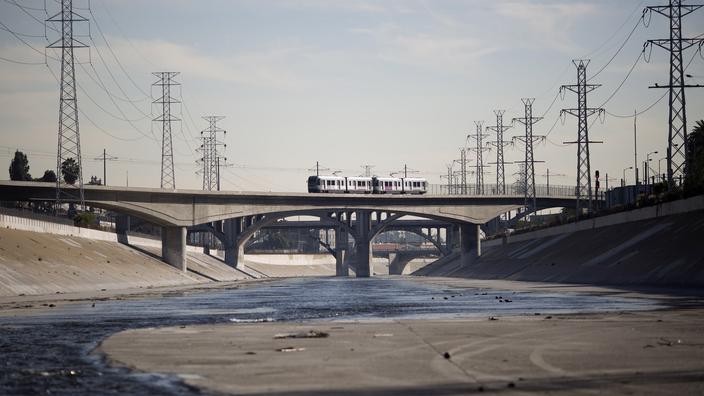Should we build landscaped slabs above the capricious river, as the American architect projects, or give it back its original bed? The debate continues to divide the Californian city.
LA River. All moviegoers know the river that crosses the Californian city, engulfed in its concrete canal. It was the impressive setting of the Point of no return by Lee Marvin or the Chinatown by Roman Polanski. From the car racing Grease, of the unlikely chase between robots of Terminator 2 or racing cars in Drive. We see a dry canal, an open sewer; the river does not really recall its nature until an impressive flood. The rest of the time, she divides Los Angeles, literally and figuratively.
Should we cover this hose where a thin stream of water normally runs in the middle of the fences? Such is the project unveiled at Los Angeles Time by architect Frank Gehry, responsible for the Los Angeles River redevelopment plan. The immense concrete canal should be camouflaged by the installation, among other things, of massive green spaces in the form of plant bridges. The initiative is as enthusiastic as it is tense, because the initial concept rather promised to find the bed of the river stripped of its concrete sheath.
Read also :Frank Gehry to redevelop the banks of the Los Angeles River
The pharaonic operation, decided in 2015 by the young democratic mayor Eric Garcetti, aims to revitalize the residential areas around the river, where poverty and insecurity are concentrated. 83 kilometers long and prone to flooding, the Los Angeles River was one of the first victims of urban planning at the start of the 20th century. Monstrous floods during the 1930s finally convinced the local authorities to channel it.
An elevated cultural center
Almost a century later, it is now a question of covering it up. Built on imposing concrete blocks and thick beams, the infrastructure planned by the 91-year-old architect will be located at the confluence of the Los Angeles River and the Rio Hondo, south of the city. Stretching over more than a kilometer and a half, these aerial walks should offer a luxuriant landscape, with picturesque “above ground” ponds, equestrian and hiking trails.
–
Gehry’s pride lies in the design of an elevated cultural center dedicated, in particular, to music, dance, painting and cinema. Programs promising to recreate social links by bringing together young people from various origins. “I think this place will become a very special place, important for future generations”, he enthuses, recalling that “The life expectancy of children south of the city center is 10 years shorter than elsewhere.” The cultural center is estimated at 150 million dollars.
Read also :Jean Nouvel, Zaha Hadid, Frank Gehry … Design at the height of architects
Anger of environmentalists
A vagueness that exceeds activists and arouses the anger of environmentalists. Some fear an increase in the price of land on the outskirts of the new district, others, including the Friends of the Los Angeles River association, point out the environmental risks or demand the promised restoration of the river in its bed rather its disappearance under a slab. While waiting for a hypothetical start of work, an amount estimated at 1.4 billion dollars and planned to last ten years, the LA River continues its course.
– .


